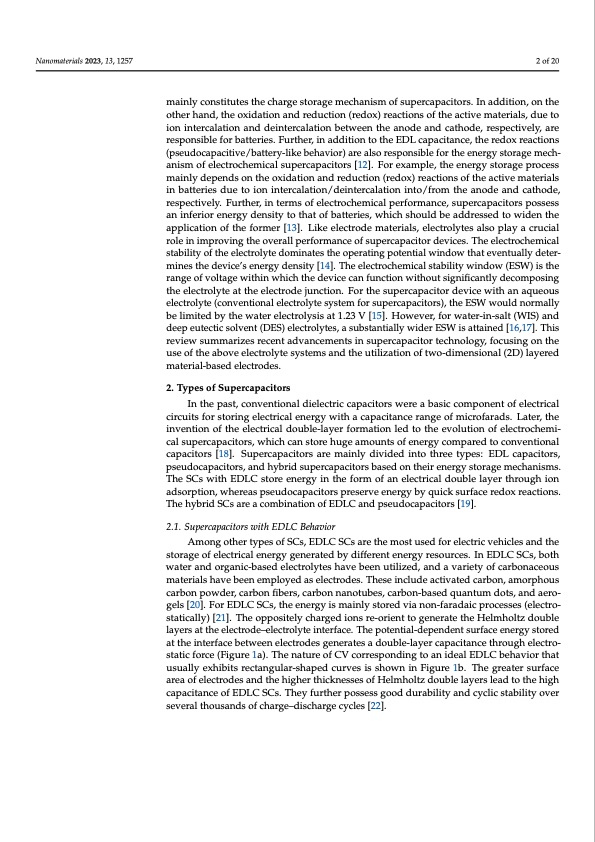
PDF Publication Title:
Text from PDF Page: 002
Nanomaterials 2023, 13, 1257 2 of 20 mainly constitutes the charge storage mechanism of supercapacitors. In addition, on the other hand, the oxidation and reduction (redox) reactions of the active materials, due to ion intercalation and deintercalation between the anode and cathode, respectively, are responsible for batteries. Further, in addition to the EDL capacitance, the redox reactions (pseudocapacitive/battery-like behavior) are also responsible for the energy storage mech- anism of electrochemical supercapacitors [12]. For example, the energy storage process mainly depends on the oxidation and reduction (redox) reactions of the active materials in batteries due to ion intercalation/deintercalation into/from the anode and cathode, respectively. Further, in terms of electrochemical performance, supercapacitors possess an inferior energy density to that of batteries, which should be addressed to widen the application of the former [13]. Like electrode materials, electrolytes also play a crucial role in improving the overall performance of supercapacitor devices. The electrochemical stability of the electrolyte dominates the operating potential window that eventually deter- mines the device’s energy density [14]. The electrochemical stability window (ESW) is the range of voltage within which the device can function without significantly decomposing the electrolyte at the electrode junction. For the supercapacitor device with an aqueous electrolyte (conventional electrolyte system for supercapacitors), the ESW would normally be limited by the water electrolysis at 1.23 V [15]. However, for water-in-salt (WIS) and deep eutectic solvent (DES) electrolytes, a substantially wider ESW is attained [16,17]. This review summarizes recent advancements in supercapacitor technology, focusing on the use of the above electrolyte systems and the utilization of two-dimensional (2D) layered material-based electrodes. 2. Types of Supercapacitors In the past, conventional dielectric capacitors were a basic component of electrical circuits for storing electrical energy with a capacitance range of microfarads. Later, the invention of the electrical double-layer formation led to the evolution of electrochemi- cal supercapacitors, which can store huge amounts of energy compared to conventional capacitors [18]. Supercapacitors are mainly divided into three types: EDL capacitors, pseudocapacitors, and hybrid supercapacitors based on their energy storage mechanisms. The SCs with EDLC store energy in the form of an electrical double layer through ion adsorption, whereas pseudocapacitors preserve energy by quick surface redox reactions. The hybrid SCs are a combination of EDLC and pseudocapacitors [19]. 2.1. Supercapacitors with EDLC Behavior Among other types of SCs, EDLC SCs are the most used for electric vehicles and the storage of electrical energy generated by different energy resources. In EDLC SCs, both water and organic-based electrolytes have been utilized, and a variety of carbonaceous materials have been employed as electrodes. These include activated carbon, amorphous carbon powder, carbon fibers, carbon nanotubes, carbon-based quantum dots, and aero- gels [20]. For EDLC SCs, the energy is mainly stored via non-faradaic processes (electro- statically) [21]. The oppositely charged ions re-orient to generate the Helmholtz double layers at the electrode–electrolyte interface. The potential-dependent surface energy stored at the interface between electrodes generates a double-layer capacitance through electro- static force (Figure 1a). The nature of CV corresponding to an ideal EDLC behavior that usually exhibits rectangular-shaped curves is shown in Figure 1b. The greater surface area of electrodes and the higher thicknesses of Helmholtz double layers lead to the high capacitance of EDLC SCs. They further possess good durability and cyclic stability over several thousands of charge–discharge cycles [22].PDF Image | Water-in-Salt Eutectic Solvent-Based Liquid Electrolytes

PDF Search Title:
Water-in-Salt Eutectic Solvent-Based Liquid ElectrolytesOriginal File Name Searched:
nanomaterials-13-01257.pdfDIY PDF Search: Google It | Yahoo | Bing
Salgenx Redox Flow Battery Technology: Power up your energy storage game with Salgenx Salt Water Battery. With its advanced technology, the flow battery provides reliable, scalable, and sustainable energy storage for utility-scale projects. Upgrade to a Salgenx flow battery today and take control of your energy future.
| CONTACT TEL: 608-238-6001 Email: greg@infinityturbine.com | RSS | AMP |